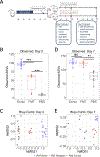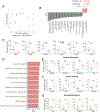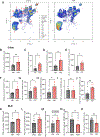Fecal microbiota transplantation stimulates type 2 and tolerogenic immune responses in a mouse model
- PMID: 38521227
- PMCID: PMC11042976
- DOI: 10.1016/j.anaerobe.2024.102841
Fecal microbiota transplantation stimulates type 2 and tolerogenic immune responses in a mouse model
Abstract
Objectives: Clostridioides difficile infection (CDI) is the leading hospital-acquired infection in North America. While previous work on fecal microbiota transplantation (FMT), a highly effective treatment for CDI, has focused on colonization resistance mounted against C. difficile by FMT-delivered commensals, the effects of FMT on host gene expression are relatively unexplored. This study aims to identify transcriptional changes associated with FMT, particularly changes associated with protective immune responses.
Methods: Gene expression was assessed on day 2 and day 7 after FMT in mice after antibiotic-induced dysbiosis. Flow cytometry was also performed on colon and mesenteric lymph nodes at day 7 to investigate changes in immune cell populations.
Results: FMT administration after antibiotic-induced dysbiosis successfully restored microbial alpha diversity to levels of donor mice by day 7 post-FMT. Bulk RNA sequencing of cecal tissue at day 2 identified immune genes, including both pro-inflammatory and Type 2 immune pathways as upregulated after FMT. RNA sequencing was repeated on day 7 post-FMT, and expression of these immune genes was decreased along with upregulation of genes associated with restoration of intestinal homeostasis. Immunoprofiling on day 7 identified increased colonic CD45+ immune cells that exhibited dampened Type 1 and heightened regulatory and Type 2 responses. These include an increased abundance of eosinophils, alternatively activated macrophages, Th2, and T regulatory cell populations.
Conclusion: These results highlight the impact of FMT on host gene expression, providing evidence that FMT restores intestinal homeostasis after antibiotic treatment and facilitates tolerogenic and Type 2 immune responses.
Keywords: Clostridioides difficile; Fecal microbiota transplantation; Intestinal dysbiosis; Microbiota signaling; Tolerogenic immunity; Type 2 immunity.
Copyright © 2024 The Authors. Published by Elsevier Ltd.. All rights reserved.
Conflict of interest statement
Declaration of competing interest Dr. Petri has a conflict of interest in that I am a consultant for TechLab, Inc., which makes diagnostic tests for C. difficile infection. The other authors have no other conflicts of interest to disclose.
Figures




References
-
- Lessa FC 2019. Antibiotic resistance threats in the United States, 2019. 10.15620/cdc:82532, Atlanta, GA. - DOI
-
- Loo VG, Poirier L, Miller MA, Oughton M, Libman MD, Michaud S, Bourgault A-M, Nguyen T, Frenette C, Kelly M, Vibien A, Brassard P, Fenn S, Dewar K, Hudson TJ, Horn R, René P, Monczak Y, Dascal A. 2005. A Predominantly Clonal Multi-Institutional Outbreak of Clostridium difficile–Associated Diarrhea with High Morbidity and Mortality. N Engl J Med 353:2442–2449. - PubMed
-
- Kuijper EJ, Barbut F, Brazier JS, Kleinkauf N, Eckmanns T, Lambert ML, Drudy D, Fitzpatrick F, Wiuff C, Brown DJ, Coia JE, Pituch H, Reichert P, Even J, Mossong J, Widmer AF, Olsen KE, Allerberger F, Notermans DW, Delmée M, Coignard B, Wilcox M, Patel B, Frei R, Nagy E, Bouza E, Marin M, Akerlund T, Virolainen-Julkunen A, Lyytikäinen O, Kotila S, Ingebretsen A, Smyth B, Rooney P, Poxton IR, Monnet DL. 2008. Update of Clostridium difficile infection due to PCR ribotype 027 in Europe, 2008. Euro Surveill Bull Eur sur les Mal Transm = Eur Commun Dis Bull 13. - PubMed
MeSH terms
Grants and funding
LinkOut - more resources
Full Text Sources
Research Materials
Miscellaneous

